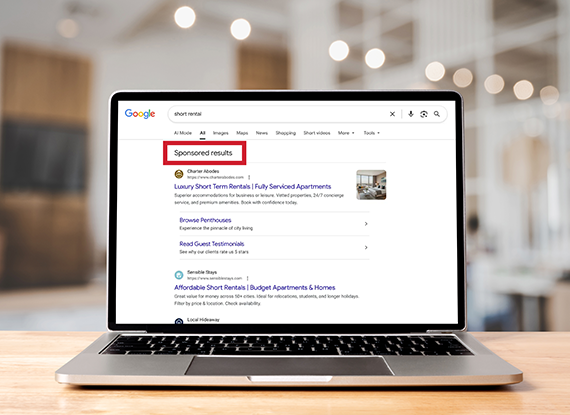Google’s New Sponsored Results Label: What This Update Means for Advertisers | Magnify Lab
Google has rolled out a significant visual update to its ad labelling system, introducing a new global “Sponsored results” header. The change, which affects both desktop and mobile search, is designed to make paid listings more transparent for users while reshaping how advertisers appear in search results.
This latest change is more than a design tweak, it’s a continuation of Google’s long-term effort to balance advertiser effectiveness with user transparency.
A Clearer Look: What’s Changing
Historically, Google has tested various labels to distinguish paid content from organic results, from small “Ad” icons to subtle text tags. Now, the search giant is consolidating those indicators under a bold new “Sponsored results” heading.
This new label appears above clusters of paid ads, meaning text ads, Shopping campaigns, and other sponsored formats will now fall under a single, unified header. The redesign aims to make the relationship between ads and organic results easier for users to understand at a glance.
In addition to the new label, Google is introducing a feature allowing users to hide groups of sponsored results entirely from their search view. While this is unlikely to cause an immediate drop in ad impressions, it does give users more control, and that may influence engagement patterns over time.
Why Google Made the Change
Google has always faced scrutiny around ad transparency. The evolution from “Ad” labels to “Sponsored” reflects the company’s intent to provide clearer disclosure about paid placements, particularly in light of global regulatory attention and shifting consumer expectations.
By grouping paid results together, Google also simplifies the visual layout of the results page. This makes it easier for users to navigate, and for advertisers, it may slightly alter the way ads are perceived, not as individual placements, but as part of a broader sponsored section.
What This Means for Advertisers
While the change may seem purely cosmetic, it carries several important implications for performance and strategy.
- Visibility and CTRs may fluctuate:
Clearer ad labels could influence how users engage with sponsored listings. Some users may skip them altogether; others may view the “Sponsored results” section as a trusted space for commercial content. Expect CTR variations in the short term. - Quality and relevance will matter more than ever:
As Google gives users more control, including the option to hide sponsored results, advertisers need to ensure that their messaging aligns closely with search intent. Ads that feel too generic or irrelevant are at greater risk of being ignored. - Perception and trust become differentiators:
Transparency can work both ways. Users who appreciate clear labelling may view high-quality ads as credible sources of information. This shift rewards advertisers who invest in trust-based, informative creative rather than purely sales-driven messaging.
A Broader Trend in Google Ads Evolution
This update is part of a much larger movement in Google’s advertising ecosystem, one where automation, user experience, and ethical transparency play central roles.
Recent updates, from the introduction of AI-powered campaign types like Performance Max to privacy-driven targeting changes, show a clear direction: Google wants to maintain user trust while ensuring advertisers can still reach their audiences effectively.
The “Sponsored results” label fits squarely within this vision. It aligns with Google’s long-term strategy to make advertising feel more native and user-centric, without misleading people about what’s paid and what’s not.
What Businesses Should Take Away
For brands and marketers, this update is a reminder that paid visibility now lives in a more transparent environment. That’s not necessarily a negative, it’s an opportunity to stand out through authenticity, creativity, and data-driven precision.
At Magnify Lab, we believe updates like these reinforce the importance of strategic campaign management. As a London based Google ads agency, we continuously adapt to platform changes, ensuring our clients’ campaigns remain competitive and compliant in a fast-evolving landscape.
Rather than worrying about lower visibility, advertisers should see this as a push toward smarter campaign optimisation, improving ad relevance, refining audience targeting, and crafting messaging that resonates beyond the click.
Google’s new “Sponsored results” label might seem like a subtle design change, but it signals a growing emphasis on transparency and user empowerment. For advertisers, it’s a call to elevate ad quality and user experience in every campaign.
While the short-term performance impact remains to be seen, one thing is clear: the advertisers who adapt fastest, with thoughtful, well-structured campaigns will benefit most in this new environment.
If you’re looking to stay ahead of every Google Ads update and maximise performance in an increasingly competitive search landscape, Magnify Lab can help. As a trusted Google ads agency, we specialise in driving measurable results through smart strategy, data insight, and creative precision.

